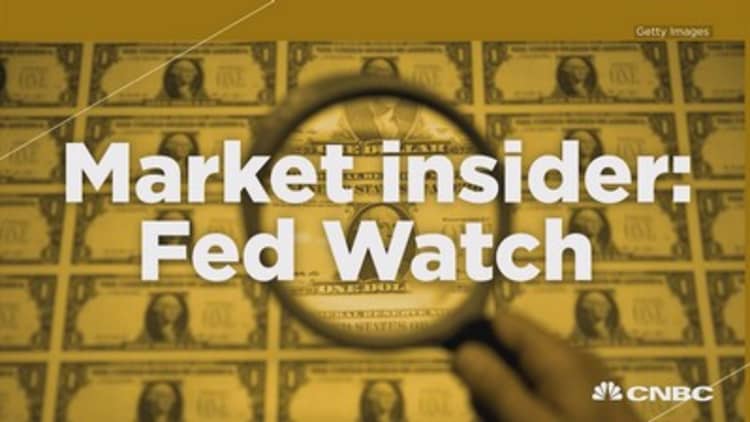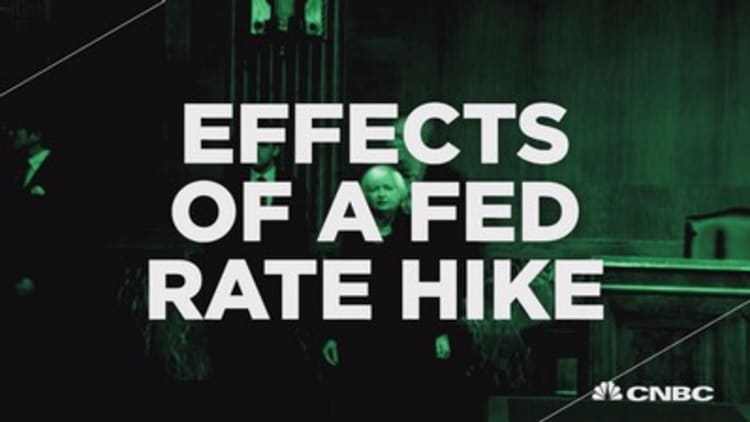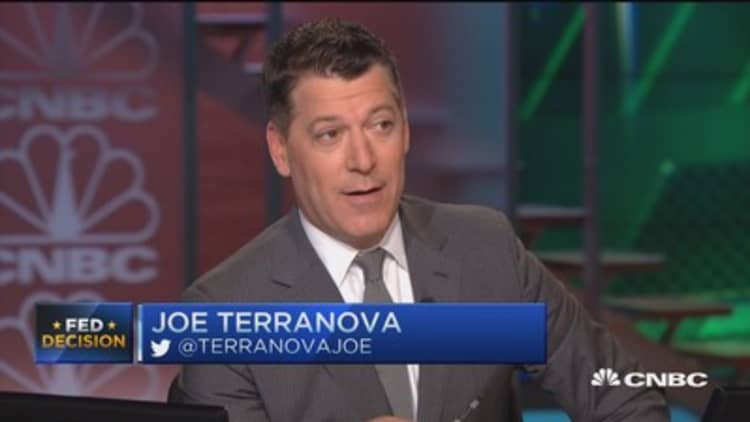



The Fed on Wednesday is expected to acknowledge the economy is improving and clear the runway for a historic liftoff in short-term rates from zero sometime later this year.
That's what markets seem to be saying, and odds are mostly on a first rate hike in September with a possible second in December. Traders also expect the Fed to be somewhat dovish, so if there are any surprises in the central bank's message, it could pack a punch when it comes to market reaction.
Here are five things to watch:
Rate hike—The Fed's June meeting is "live," meaning it could hike rates Wednesday if it so chooses. However, the market odds of that are zero, so a surprise early rate rise would not just rock, but shock the markets.
Bond yields were higher Wednesday on expectations the Fed would sound more hawkish about rate increases in its statement. But the market is certainly not poised for an imminent hike.
Read MoreWall Street sees rate hike in Q3
Data dependent—The Fed is expected to downgrade its 2015 GDP forecast of 2.3 to 2.7 percent due to first-quarter weakness. But at the same time, it's expected to talk up improvements in the economy more recently. It is also likely to re-emphasize that its decision to hike rates will be data dependent and that it needs to see continued progress in the economy and strength in labor.
Peter Boockvar of The Lindsey Group said if the Fed just emphasizes it is data dependent with no clues on timing for its first rate increase, it would be "more of the same old."
"What they should do and will do are two different things. it's just a question of whether they lay the groundwork for July or September. They're going to have to acknowledge the data between now and April. They're running out of meetings to prep us. I think we're getting close to an inflection point. If the Fed doesn't raise rates soon, the market will do it for them." Boockvar said.
He also said the central bank needs to acknowledge the increase in wage growth and inflation, present in last month's CPI but not in the PCE data that the Fed watches.
"At the March meeting, they had a 1.6 percent core CPI. Today core CPI is 1.8," he said. Fresh CPI data for May will be released Thursday.
So any comment on inflation will be significant. "I think that's the Fed's trigger now. That's what they're looking at as far as how they're going to time their normalization of rates. That's the one aspect of the economy that's keeping them from the liftoff hike. If we get a trend higher in inflation, that would be an indicator that they are going to be more comfortable with liftoff," said Ian Lyngen, senior Treasury strategist at CRT Capital.
Read MoreHere's what happens to markets when Yellen speaks
Balance sheet—There is some market talk that Fed Chair Janet Yellen could address the Fed's $4.5 trillion balance sheet during her 2:30 p.m. ET briefing Wednesday. The balance sheet ballooned with the extraordinary programs like quantitative easing that it launched to battle the financial crisis.
The balance sheet is viewed by the central bank as a monetary tool that can be used to control long-term rates, so it was not expected to discuss its plans for the balance sheet until next year, after it began raising short-term rates.
Read MoreMarkets curious about Fed's 4 trillion shades of gray
Economists don't expect the Fed to talk about the balance sheet yet, but some strategists have speculated that the Fed may be asked to comment on its plans.
The central bank currently reinvests the proceeds from its mortgage holdings and also purchases replacements for maturing Treasury and mortgage securities as they roll off the balance sheet. But "normalization" of policy could ultimately change all of that as the Fed looks to gradually reduce the size of the balance sheet.
The Fed bought a small amount of replacement securities this year but traders are eyeing $200 billion in securities that mature in 2016, and they are wondering whether the central bank will replace them or alter its program.
Read MoreThis would be scary enough to give the Fed pause
"If they were to release (details) at this meeting, this would be a surprise, and rates would rally hard," said Nomura rate strategist George Goncalves. "If they were to save it for September, it would dampen the blow of rising rates. It's not insignificant."
Connect the dots—The Fed presents its officials' projections for the path of interest rates in a chart, called the "dot plot." Fed watchers expect the path for these dots to come down a bit with a lowering of the higher-end rate forecasts in 2016 and 2017.
That's one thing traders expect would establish a more dovish tone when the Fed releases its projections and statement at 2 p.m. ET. There's even some speculation Fed officials could lower their 2015 expectations.
However, Alan Ruskin, head of G-10 currency strategy at Deutsche Bank, says he doesn't believe a shift down in dots would necessarily be dovish. But an important signal instead would be if there are enough FOMC members thinking that two rate hikes are likely in 2015, which means September is the probable liftoff date. Ruskin said the fed funds futures market is currently pricing September as a "coin toss," which is a probability that is too low.
Exogenous shocker—The Fed is expected to discuss the implications of a Greek default and "Grexit" from the euro. But it is not expected to say much about it publicly other than it is watching international situations. While very unlikely, should Yellen speak about Greece as a major concern, traders could see it as a hurdle to a rate increase and push back their own projections. Economists only expect Greece to delay rate hikes if it wreaks havoc in markets and financial conditions worsen because of it. The situation is something the Fed will keep an eye on.


